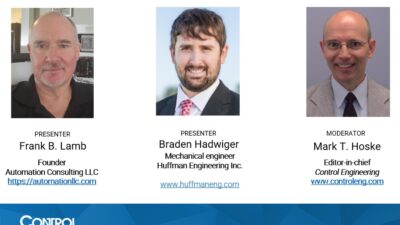Here's how to augment feedback control with feedforward control.
Feedback control
 Driving a bumper car in reverse forces the driver to wait until after a disturbance has occurred before making a course correction.
Source: Control Engineering
|
 Driving forward allows the driver to visually measure an impending disturbance, anticipate its effect on the car’s future trajectory adn correct course.
Source: Control Engineering
|
Traditional feedback control has been likened to driving a bumper car backwards. Without a view of the track ahead, the driver must look backward to decide where to go. Steering correction can only compensate after the car is off course.
Feedforward control is more akin to driving the car forwards so that the driver can make steering corrections just before reaching the next curve. When the driver sees that an obstacle ahead will disturb the desired trajectory, preemptive action can minimize the impending deviation.
In industrial applications, a feedforward controller can similarly minimize the effects of a disturbance, but only if the disturbance can be measured or calculated before it affects the process variable. A classic example is a steam distribution system where a central boiler provides steam at a constant pressure to plant equipment.
When an idle machine comes on line and starts drawing steam from the boiler, the pressure controller can preemptively turn up the heat and inject more water into the boiler if it knows how much steam the machine will need. If it were to rely strictly on feedback, the pressure controller would have to wait until the boiler pressure dropped before attempting to compensate for the new load.
The trick to effective feedforward control is accurately predicting the effects of measured disturbances. An experienced bumper-car driver can easily decide how to steer around an upcoming obstacle. With steam distribution, a feedforward pressure controller would need to know exactly when a particular machine will come on line and how much steam it will need.
Mathematical models can predict how a process responds to measurable disturbances and to the controller’s efforts. Since a model never can be 100% accurate and because other unmeasurable disturbances may also affect the process variable, a feedforward controller is almost always combined with a feedback controller, for the best of both worlds.
The feedforward controller makes its best guess about how to modify the control effort to compensate for an impending disturbance, and the feedback controller takes up the slack. It measures the net effect of the disturbance and the feedforward controller’s preemptive efforts then compensates for any deviations in the process variable that the feedforward controller could not prevent.
Feedforward controllers can be difficult to implement, especially if process behavior is not well understood or if disturbance variables are hard to measure or too many. A poorly-designed feedforward controller can also amplify a disturbance and make the feedback controller’s job harder.
Still, feedforward controllers can be worth the effort if disturbances are so frequent or so large that a feedback controller alone cannot keep up. A well-designed feedforward controller can reduce the effects of major load changes to mere blips in the process variable.
| Author Information |
| Vance VanDoren, Ph.D., P.E., is Control Engineering consulting editor, at [email protected] . |



